Ten days before Liverpool regionals, I felt ready. I liked the new hybrid build of Mew VMAX (see https://www.tcgpark.com/blog/solving-the-mew-vmax-dilemma) and felt confident with it.
Three days before Liverpool, I was lost. Giratina VSTAR had just won Charlotte regionals, so with two wins in a row, it was bound to be on everyone’s minds. Mew VMAX was the main deck that’s supposed to beat Giratina, so it felt like too obvious a play. I expected people to get wise and play Spiritomb or Drapion V. Roaring Moon was also on the rise, and Charizard is always one of the top two most played decks. Mew VMAX can beat all of these decks, but not confidently, and I didn’t want to play a whole day (and hopefully two) afraid of everything my opponent could flip up.
I felt that the right metacall, as far as it exists, was Lost Box, either SableZard or a Kyogre variant. Lost Box was pretty good against Giratina (as long as Giratina doesn’t play Jirachi and Manaphy, but that was not at all how Giratina tended to be built), and it was also very effective against the new hot deck, Roaring Moon, while Kyogre was a win condition against Mew VMAX (among others).
Unfortunately, I hadn’t played Lost Box in a while; I did try to build it again two days before the event, but I wasn’t confident in my decklist, and it wasn’t a deck I felt comfortable bringing without preparation, not to mention that I’ve come to hate the dilemmas that Lost Zone decks can force on a player.
Gardevoir seemed like another good deck for the event, due to Miraidon’s declining popularity, and good matchups against Mew (as long as Judge Path doesn’t ruin everything), Roaring Moon, Lost Box, and Charizard. But it was another deck that I wasn’t comfortable bringing, since I’m not the fastest player and the deck requires a very fast pace of play to avoid ties.
I tried a few other ideas but kept losing to Giratina. Then I thought about going back to Giratina, but kept losing to everything (but mostly to Lost Box, and to my own terrible opening hands).

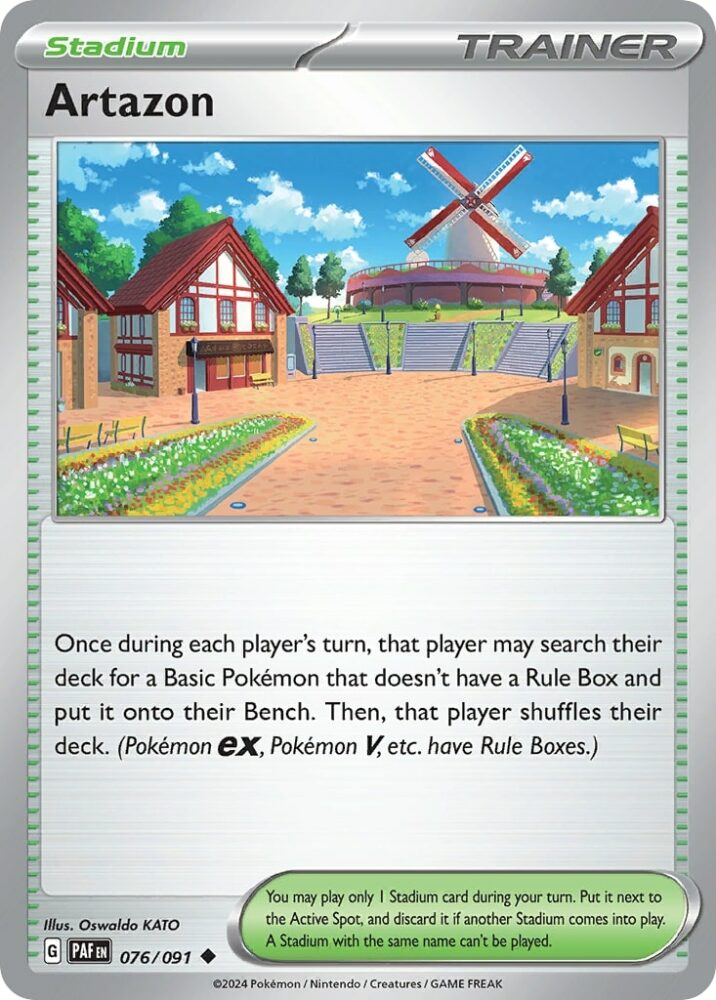
At a loss, I asked some of my friends for help. One of them, João Pedro Medeiros, who I consider to be one of the best deck builders in the world, sent me the Charizard ex list he was farming League Cups with. He had included three Artazon for a total of six outs to Path to the Peak, while also giving the deck easier access to Manaphy and Jirachi. With this, he claimed, he was favored against Giratina. That was enough for me; I changed two cards (cutting Nest Ball for Switch since I didn’t want to lose to random paralysis cards like Tapu Koko ex, and TM Devolution for Justified Gloves, which I’ll discuss later) and sleeved the deck.
| Pokemon | Trainers | Energy |
|---|---|---|
| 3 Charmander PAF 7 | 4 Arven OBF 186 | 7 Fire Energy |
| 1 Charmander OBF 26 | 3 Iono PAF 80 | |
| 1 Charmeleon OBF 27 | 3 Boss’s Orders PAL 172 | |
| 3 Charizard ex PAF 54 | 1 Professor’s Research PAF 88 | |
| 2 Pidgey MEW 16 | 4 Battle VIP Pass FST 225 | |
| 2 Pidgeot ex OBF 164 | 4 Rare Candy PAF 89 | |
| 1 Mew CEL 11 | 4 Ultra Ball PAF 91 | |
| 1 Manaphy BRS 41 | 2 Lost Vacuum CRZ 135 | |
| 1 Jirachi PAR 126 | 1 Level Ball BST 129 | |
| 1 Lumineon V BRS 40 | 1 Counter Catcher PAR 160 | |
| 1 Rotom V CRZ 45 | 1 Switch SVI 194 | |
| 1 Super Rod PAL 188 | ||
| 1 Forest Seal Stone SIT 156 | ||
| 1 Vitality Band SVI 197 | ||
| 1 Justified Gloves CRE 143 | ||
| 3 Artazon PAF 76 | ||
| 1 Collapsed Stadium BRS 137 |
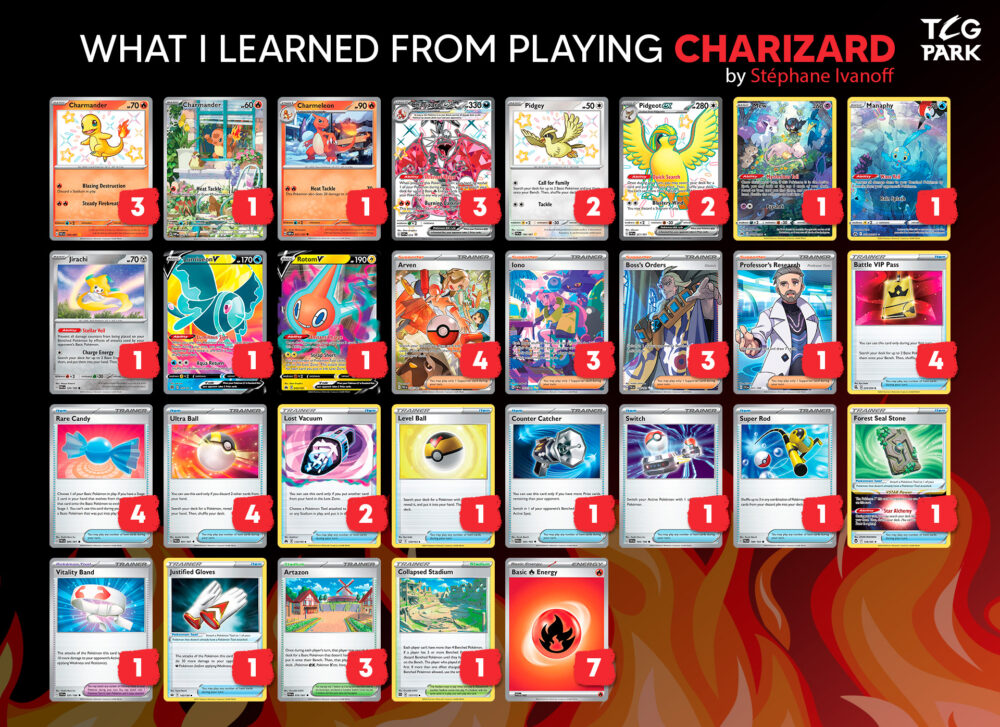
I rarely change my deck at the last minute; when I do, it’s for another deck that I’ve practiced a lot. But while I’ve played Charizard ex at LAIC and Gdansk regionals, it was the Bibarel version. I’ve played the Pidgeot version a little, mostly for coaching sessions, but I hadn’t practiced specifically with it. Nevertheless, it felt like a solid choice, and the deck is not too difficult to pick up, so I wasn’t particularly afraid. I also confess that I’ve often been envious of players who can pick up a deck the day before the event on their testing group’s recommandation, and find great success with it. This seemed like an opportunity to try my hand at this myself, and see what came of it.
Stepping out of my confort zone was honestly a positive experience. I went 7-2 in day 1 and 2-2-2 in day 2, ending up at 68th place out of more than 1500 players. While I’m disappointed that I couldn’t place higher (especially since I can’t complain about my matchups overall), trying something new taught me a few lessons – about the deck, the game and the metagame. In this article, I’d like to share this knowledge.
The Charizard ex mirror match
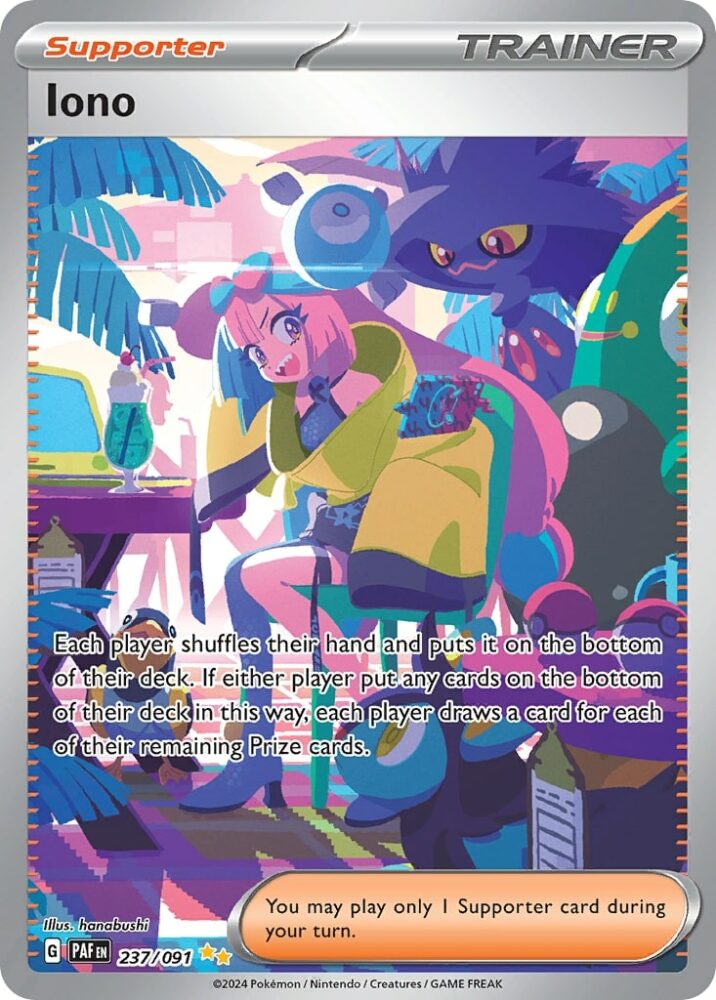
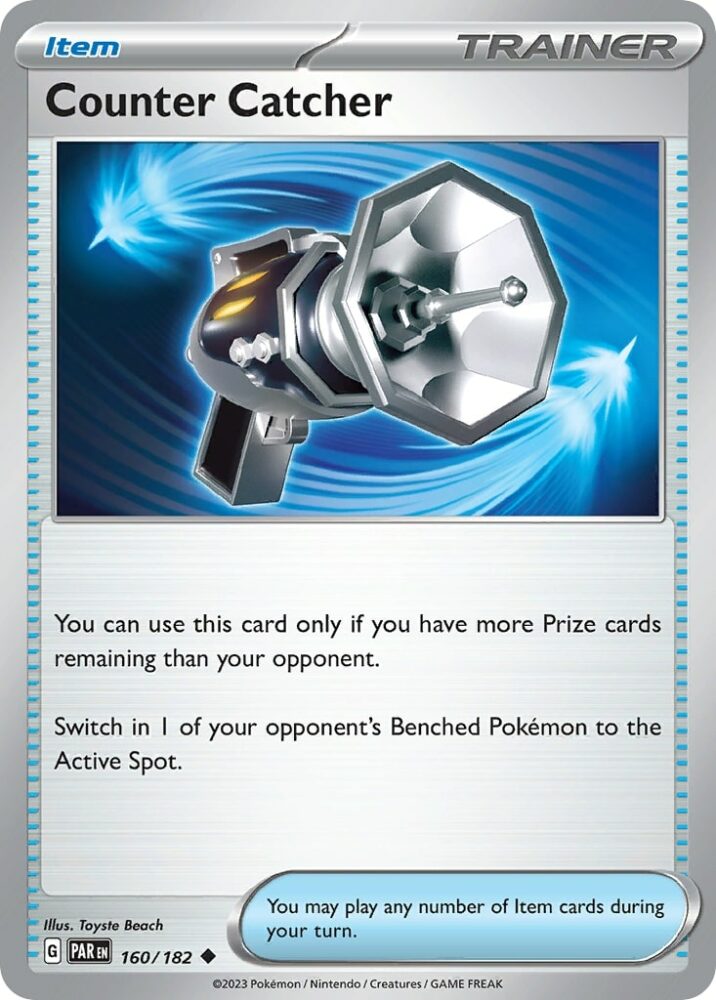
Recently, someone posted a tier list of mirror matches in the Standard format, and Charizard was ranked in the highest tier, of mirror matches where the better player usually wins. After playing the matchup quite a bit during the event, I have to admit I’m pleasantly surprised by it. It’s not that Charizard ex / Pidgeot ex is the most intricate deck of all time: you deal damage, and you search one card per turn as long as you have Pidgeot ex in play. But there’s a crucial factor: control over what the opponent does.
Charizard ex’s damage is incredible for its Energy cost, but crucially, it depends on how many Prizes the opponent has taken. This means that if you don’t take Prizes, the opposing Charizard ex deals less damage, which makes it easier for you to navigate the matchup. The player not in the lead also has access to Counter Catcher, another great option to catch up. This means that getting ahead in the mirror match does not automatically lead to a win; in fact, in many cases, it’s better to be behind.
Here’s an example: As every Charizard player knows, Charizard ex’s maximum damage output is 330, and it occurs when the opponent has taken five Prizes. In the mirror match, it’s almost always a mistake to go down to one Prize. For example, let’s imagine you’re down to one Prize with two (undamaged) Charizard ex and a Pidgeot ex in play, and your opponent still has four Prizes to take. This is actually a terrible position to be in, assuming your opponent has a decent hand. They can play Iono and Counter Catcher on your Pidgeot ex, and take it out to go down to two Prizes. You can’t OHKO their Charizard ex because you still only deal 300 damage at this point, and you just got Iono’s to one card. If you can’t find the Boss’s Orders to win the game, on the next turn, the opponent can simply KO your Charizard ex with theirs and win the game.
Note that if the opponent had three Prizes left and not four at the beginning of this scenario, then you’d actually be winning! If they KO Pidgeot, they go down to one Prize and you can KO their Charizard; if they don’t KO Pidgeot, then you can search the winning Boss’s Orders on the next turn.
I don’t have an exact map to winning the mirror match, but a solid guideline is to deal with Pidgeot ex when possible. Even taking out Pidgey before it can evolve is very beneficial; it can delay the opponent’s setup and, if they don’t have Pidgeot ex, they will be much weaker to Iono later in the game. Similarly, Forest Seal Stone (which also helps the setup) has a lot of value. Several opponents have played it early in the matchup, typically on Rotom V on turn 1, without actually using it, just in case I play Iono. I think that’s a mistake, as it allows me to use Lost Vacuum (which is otherwise fairly useless in this matchup) to get rid of it and deny them value. Charizard plays four Arven, so it’s not difficult to find Forest Seal Stone again even if Iono is played.
The flip side is that, as long as an opponent’s VSTAR Power hasn’t been used, taking out their only Pokémon V in play can be surprisingly high value. It might seem useless to get rid of Rotom V in the midgame, but if they can still attach a Forest Seal Stone to it, then it actually denies them consistency options.
Of course, the matchup is also influenced heavily by techs. This brings me to my next point.
Techs and closed decklists
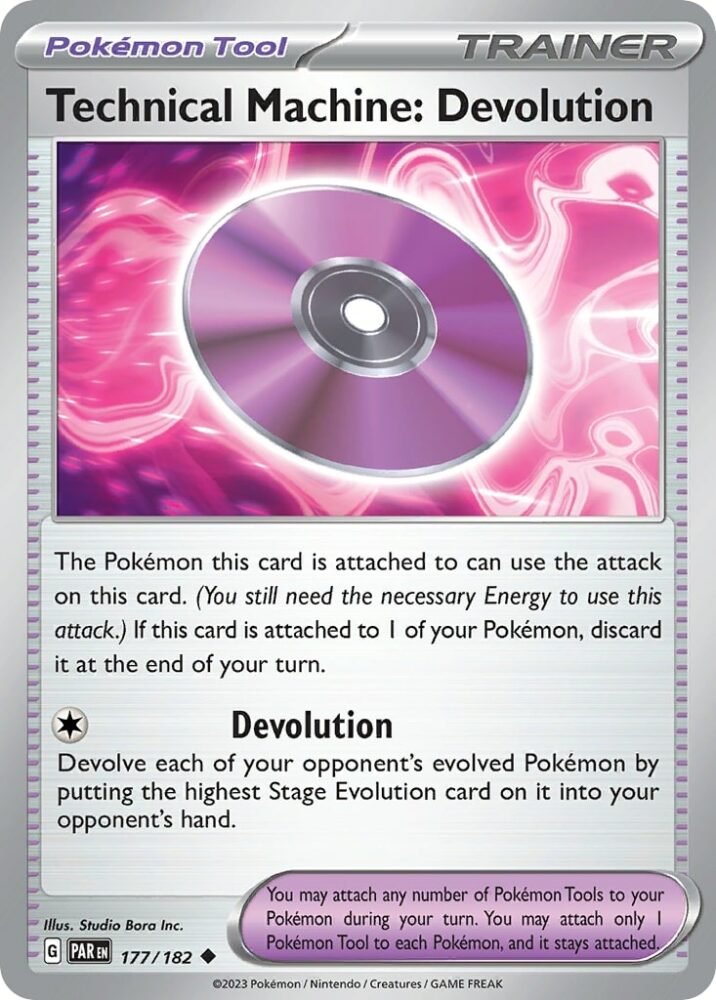
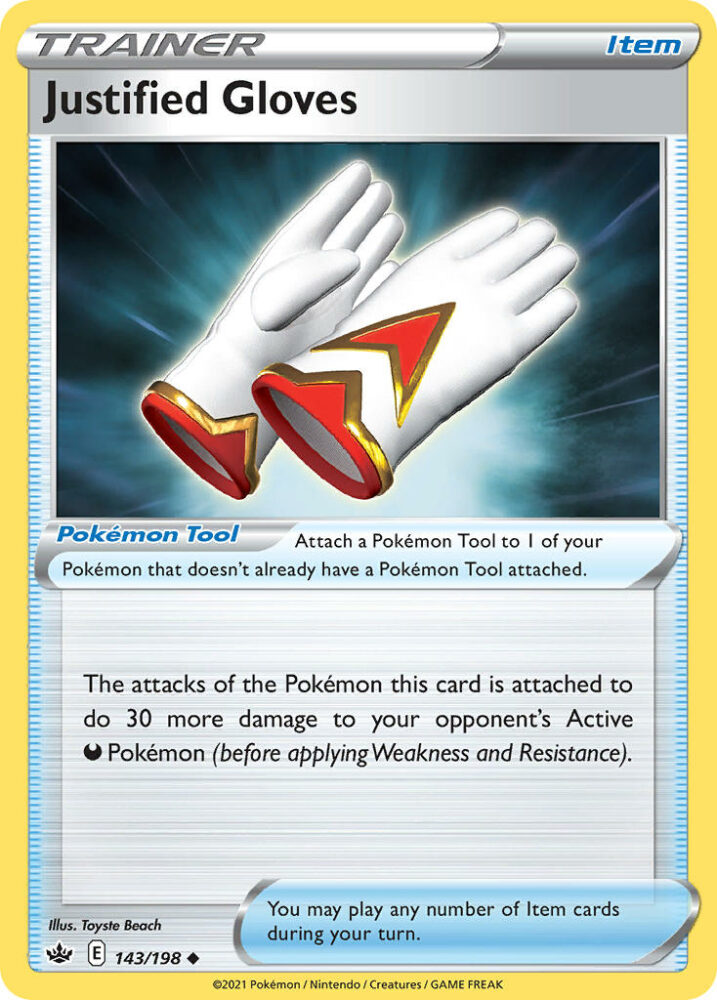
There are two main techs that can be played for the Charizard ex mirror match: Technical Machine Devolution and Justified Gloves.
TM Devolution has become the more common option. It’s very strong in the mirror match because of how much the deck relies on Rare Candy. Devolving a damaged Charizard ex takes a KO, but it also removes Pidgeot ex from play. Since there’s a limited supply of Rare Candy in the deck, a player must be very careful to use them correctly when facing a deck with TM Devolution. Setting up two Charizard ex at the same time, for example, is a mistake (except when one of them was evolved through Charmeleon). Playing around TM Devolution is interesting, as it’s usually perfectly possible, but requires restraint.
In round 5 in Liverpool, I was paired against Laurens van Brecht, a Dutch player who’s been away from the game for a while, but whose skill I knew very well. He fetched his TM Devolution early in the game and used it to devolve my Pidgeot ex and Charizard ex. I was surprised, as I hadn’t used too many resources and he didn’t disrupt my hand at the same time; it felt like an suboptimal use of ressources. I briefly wondered if he could be playing two copies of the card, but dismissed this idea since I hadn’t seen any Charizard list do that.
This was a crucial mistake. My intuition had been right: Laurens was indeed playing two copies of TM Devolution, and after I reevolved Pidgeot and Charizard, he devolved them again, forcing me to evolve only through Charmeleon. I think that my lack of experience playing Charizard / Pidgeot betrayed me, as if I had been more used to playing against TM Devolution, I would have been able to identify what was going on. I also like to think that, if I played at my best level, I would have followed my intuition and played around that second copy.
When I mentioned what happened this round, a friend mentioned that one of my countrymen, Antoine Betti, had been playing two copies of TM Devolution as well recently. Strangely enough, I found myself matched against Antoine later in the tournament, in round 9. I didn’t know his list, but the possibility of a second TM Devolution was in the back of my mind, and I played more cautiously. I won game 1 because he bricked, but in game 2, I delayed evolving my Pidgeot ex to play around Devolution. It turns out he was indeed playing two copies, but the second one was in his last two Prizes. Nevertheless, I think that my loss in round 5 helped me to better play around it, and helped me win that round.
As for myself, I didn’t play Devolution, but Justified Gloves. There were three reasons for that choice. First, I didn’t have any experience playing TM Devolution in Charizard and I was worried I wouldn’t use it at the right time. Second, Roaring Moon had been doing well recently, and I knew the matchup wasn’t easy. In round 7, I played against Laura Takeda, who ran Roaring Moon, and Justified Gloves let me KO her Roaring Moon ex after it took the first Prize, basically winning me the matchup (it’s a fairly simple Prize race, so if I can take the first two-Prize KO, I’m basically winning). But Justified Gloves was also important in the mirror match, since it let me KO a Charizard ex if the opponent has two Prizes left, not one. Since many players had cut Justified Gloves from their lists, most of my opponents didn’t think I’d play it, and it won me several games over the course of the game. My round 15 opponent, Adel Moussaoui, was playing Lost Zone Charizard ex, and I won a close game thanks to Justified Gloves. He remarked that he should have played around it, which is true, but I don’t blame him for not doing so. Meanwhile, I was trying to play around TM Devolution in case he had it, though he didn’t run it.
There was a debate two weeks ago on Twitter about whether we should play with open decklists, that is, with each player having access to their opponent’s decklist during the match. (Fun fact, no matter when you’re reading this article, there’s about a 50% chance that this sentence is true.) In VGC, tournaments are now ran using open teamsheets, so that the element of surprise (for example, an unusual Tera Type) doesn’t completely decide games. In TCG, though, I think that there’s a lot of merit to keeping closed decklists, as they favor innovation and reward game knowledge. If we had played with open decklists, I would have known that Laurens was running two copies of TM Devolution and I could have played around that, as best as I could; I wouldn’t have been punished for failing to recognize that the way he played was indicative of a second copy. I wouldn’t have been rewarded, either, for taking that possibility into account in my games against Antoine. And my opponents would have known I was playing Justified Gloves, instead of having to infer that from the way I played, and my apparent lack of TM Devolution. I think that it’s good that players can be rewarded when they make these difficult calls, so I like closed decklists. (I think it’s reasonable to make an exception for top 8, though: at this point, there’s a risk that some players have been on stream and others haven’t, and since players know who they’re going to play against, they could know who to watch or have their friends watch, and there could be an imbalance of information. I’m fine with the element of surprise being taken out of the equation at this point.)
Ties and brackets


After eight rounds in Liverpool, I found myself at 6-2 and faced the classic dilemma: ID to guarantee day 2, or play it out. Even though I was paired against someone I knew, I had resolved to play it out since I was aiming for a high placement, not simply a spot in day 2. With tournaments getting bigger and bigger, I think the decision is easier than ever: starting day 2 at 6-2-1 doesn’t feel good, at least for me.
There was another reason for my decision to play, though. Charizard ex is a deck that works well against other straightforward attacking decks, like Miraidon and Roaring Moon. These decks tend to play fast, so they get fewer ties. On the other hand, Charizard can struggle with decks like Gardevoir and especially Snorlax Stall, decks that tend to play slower and are more likely to tie.
In other words, as long as I didn’t tie, I was more likely to face good matchups. At the beginning of day 2, we were seven players with a 7-2 record, playing the following decks: two Charizard (including myself), two Roaring Moon, Miraidon, Giratina, and Arceus/Regigigas. These matchups are definitely not autowins, but they are pretty good (Justified Gloves gave me more confidence in the Roaring Moon matchup). On Sunday morning, I felt that round 10 would be the most important of the day. If I won, I would stay in the “no ties bracket”, playing against other players with no ties (so, probably not Gardevoir or Snorlax), which would make my matchups better on average. Of course, it’s not a certainty; Gardevoir players can avoid ties (Gustavo Wada made top 8 in Charlotte with a 12-3 record, for example), and at 8-2, I could also be paired up, or downpaired, or even face someone with a 7-0-3 record. Still, it felt like I would be on a favorable path if I managed to win my first round.
Unfortunately, I was paired against Owyn Kamerman’s Arceus / Regigigas, arguably the worst matchup that I could hit (outside of a downpair against a 6-1-2 Snorlax or something). I got a tie, putting me at 7-2-1, and from then on, I could hit basically anything. I proceeded to play against Miloslav Posledni’s Gardevoir in round 11, and lost, taking away my chances at making top 8.
As far as I know, Pokémon is unique among TCG for having such a high tie rate, and I don’t think we’ve explored the consequences of that enough. Some decks are more or less likely to tie, and not only is that something that I’ve decided to take into account when choosing a deck for an event, I think it’s also worth thinking about how that affects the decks you’ll face. Roaring Moon has a bad Gardevoir matchup, but in a best of three event like a Regionals, Roaring Moon will rarely tie (as long as its pilot plays at a good pace), while Gardevoir is far more likely to do so. I actually think that one reason for Roaring Moon’s recent success is that if it can avoid its bad matchups in the first few rounds, it becomes more likely to hit decks like Miraidon or Mew and to avoid Gardevoir and Lost Box, who are more likely to have at least one tie.
Technically, this isn’t a revelation, as I first noticed this phenomenon during an online event, Limitless Online Series’s Major#4 (Expanded) back in May 2021. In this event, a few French players had decided to run a tanky Bronzong deck. Honestly, it wasn’t very good in to the metagame, but it did consistently beat Stall, one of the best decks in the format. The Bronzong player who did the best in that event was Julien (who you may know as the creator of Pokédata), for an unusual reason: he got a tie early in the tournament. In online events, games go faster so it was unusual to get ties, even in bo3. The deck most likely to get a tie was Stall. Since Julien had a tie, he would get paired against other players with a tie, and most of these were Stall players, who we would beat. He had shifted into the “tie bracket”. I realized afterwards that, although Julien didn’t do that on purpose, it would actually have been a good strategy! Offering an ID in the very first round in order to get better pairings for the rest of the tournament would probably have yielded better results for me than getting a win.
Two years later, I found myself asking the same kind of questions. Should I have scooped to Owyn rather than get the tie in round 10? No, because most players at 21 points after ten rounds would have a 6-1-3 record, not 7-3 (since the only 7-3 are players at 7-2 who lost their round 10, given that 6-3 players were out of the tournament), so I was unlikely to be paired against a non-tying player. But if you’re, say, a Roaring Moon at 8-2, maybe a loss in round 11 would is better than a tie, to avoid getting in
On playing the same deck
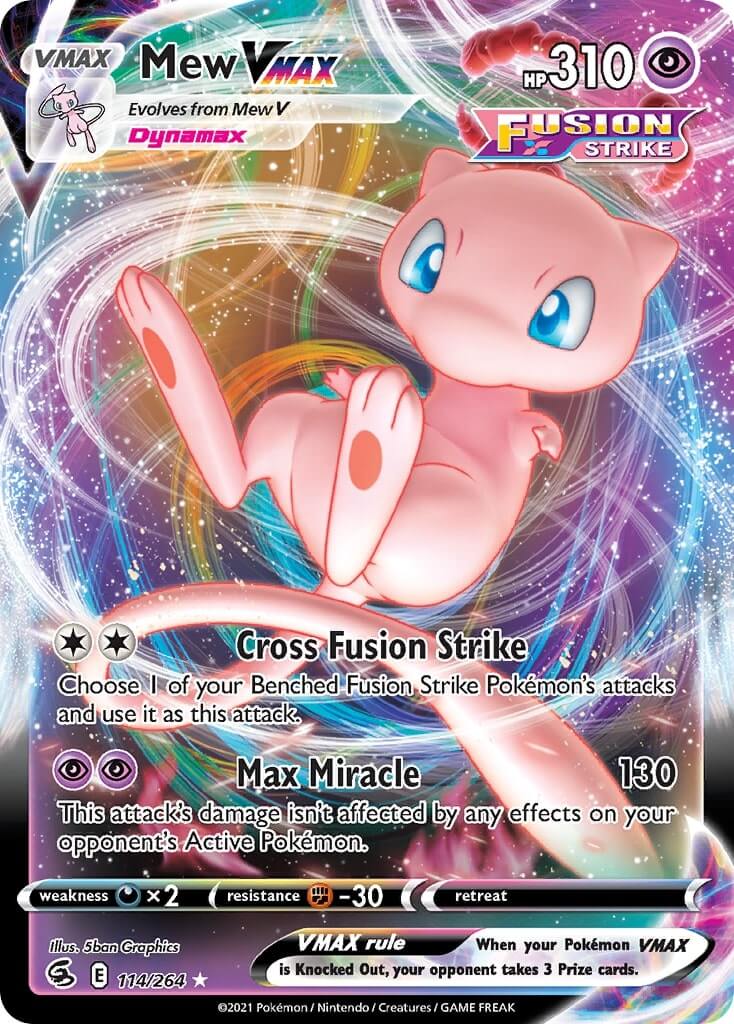
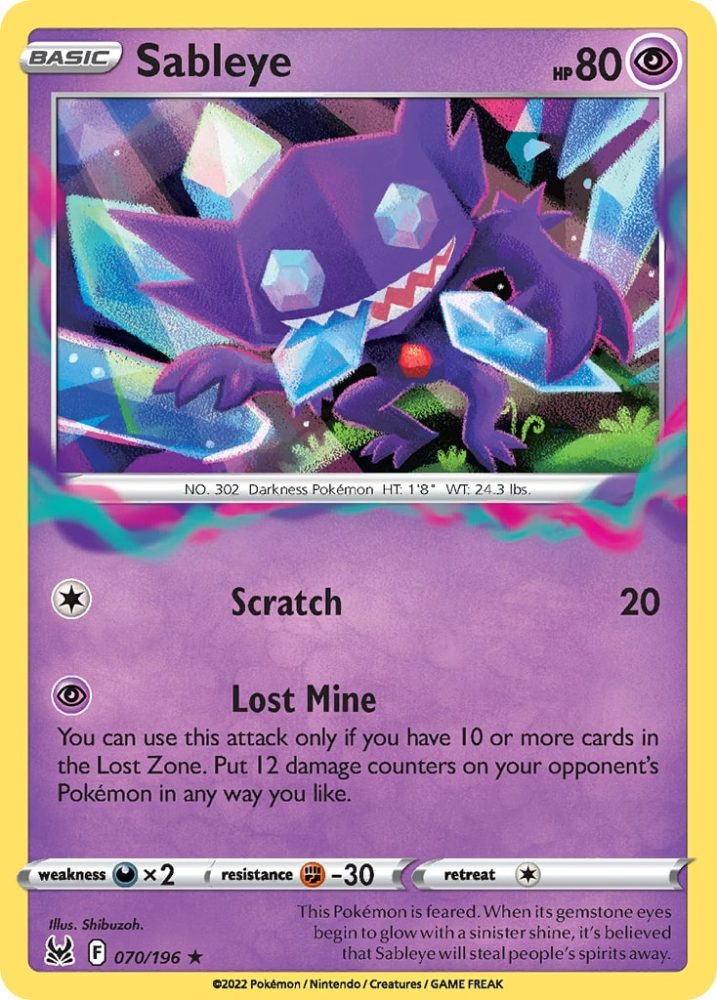
At some point during day 2, I found myself thinking that it must be nice to be one of these players who always play Mew VMAX. While I’m worrying about what to play at any given event, these players are sleeving Mew VMAX, like they’ve done for almost two years, without wondering if it’s the ideal play. I might sound sarcastic, but I’m honestly not: I think there’s incredible value in being a specialist of a given deck. Mew VMAX is famous for having so many dedicated players (such as the current World Champion, Vance Kelley), but of course it’s not the only one. You probably know someone who only ever plays Gardevoir, or Lugia, or Rapid Strike. In Europe, Brennan Kamerman is known for only ever playing one-Prize decks. Since Lost Origin released, he’s only played Lost Box (as far as I’m aware). In this format alone, he made top 8 at LAIC and top 4 at Liverpool with SableZard. He changes his list every event, but there’s always four Comfey in it.
Early in the season, I was only playing Giratina but, after doing poorly with it at Worlds and in Barcelona, I decided I needed to branch out and play more decks. Now, I’m wondering if I made the opposite mistake. In trying to be able to play anything, I’ve become more flexible, but not as good. Brennan knows SableZard better than I know any deck in the format. Alessandro Cremascoli knows Snorlax Stall better than I know any deck in the format. Even for decks that I’ve played and that I consider myself decent with, like Gardevoir, I sometimes refer to local players I know who’ve played the deck more consistently than I have, if I’m not sure how to play some matchup or what are the pros and cons of two cards.
If you focus a lot on a single deck, you might be predictable (especially at local events), and you might need to adapt when your deck rotates, but at major events, you’ll be better prepared to face anything. Focusing on a deck also doesn’t mean that you never change your decklist, either: plenty of dedicated Mew players have switched between Fusion Mew and DTE Mew depending on the metagame.
I think it’s good to be able to play various decks (and as a coach, it’s a necessity for me to know more than a single deck), but I think I’ve spread myself too thin trying to master too many archetypes. I’ve felt for a while that I’m running after the metagame, trying decks out after they win, picking them up when other players have learned how to counter them. I won NAIC 2019 because I was the best Zoroark / Dewgong player in the world; I’d tested so many techs in that deck that I knew what worked and what didn’t work, and why, and I’d learned how to play every matchup. In order to achieve the same level of success again, I need more focus. If you’re changing decks too often, maybe you too should consider sticking to one of them for a while. (You don’t have to play it non-stop for two years, though!)
Conclusion
Thanks for reading my thoughts! This article was a bit more personal than my usual, but I like to try different writing styles. If I get better at Charizard, maybe a can write an actual in-depth guide to the deck soon?
Stéphane